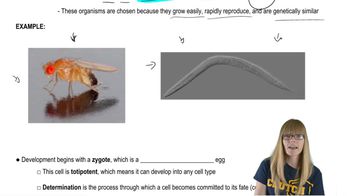14. Genetic Control of Development
Studying the Genetics of Development
Practice this topic
- Multiple Choice
During early development, human cells determine their differentiated fates based on the environment. What term describes this phenomenon?
- Multiple Choice
The variable gene activity hypothesis states that cell differentiation and determination is controlled through differences in gene activation or inactivation.
- Multiple Choice
If an embryonic cell is damaged in an organism that undergoes mosaic determination, will the offspring produced develop normally or abnormally?
- Open Question
Explain why many developmental genes encode either transcription factors or signaling molecules.
- Open QuestionWrite a short essay based on these concepts that outlines the role of differential transcription, gene control of cell fate, and the role of signaling systems in development.
- Open Question
Bird beaks develop from an embryonic group of cells called neural crest cells that are part of the neural tube, which gives rise to the spinal column and related structures. Amazingly, neural crest cells can be surgically transplanted from one embryo to another, even between embryos of different species. When quail neural crest cells were transplanted into duck embryos, the beak of the host embryo developed into a shape similar to that found in quails, creating the 'quck.' Duck cells were recruited in addition to the quail cells to form part of the quck beak. Conversely, when duck neural crest cells were transplanted into quail embryos, the beak of the embryo resembled that of a duck, creating a 'duail,' and quail cells were recruited to form part of the beak. What do these experiments tell you about the autonomy or nonautonomy of the transplanted and host cells during beak development?
- Open QuestionCarefully distinguish between the terms differentiation and determination. Which phenomenon occurs initially during development?

